Using DMAIC to improve Speed, Quality, and Cost
DMAIC简介

DMAIC简介在企业追求6西格玛的过程中,有很多方法和工具。
其中一个重要的方法,是一个五个阶段的改进步骤DMAIC(发音为Deh-maik):界定(define)、衡量(measure)、分析(analyze)、改善(improve)与控制(control)。
透过这些步骤,企业的投资报酬率自然会增加。
界定(define)界定核心流程和关键顾客,站在顾客的立场,找出对他们来说最重要的事项,也就是「品质关键要素」(Critical to Quality,CTQ)。
厘清团队章程,以及核心事业流程。
衡量(measure)找出关键评量,就是要为流程中的瑕疪,建立衡量基本步骤。
人员必须接受基础机率与统计学的训练,及统计分析软件与测量分析等课程。
为了不造成员工沉重负担,不妨让具备六个标准差实际推行经验的人,带着新手一同接受训练,帮助新手克服困难。
对于复杂的演算问题,可提供自动计算工具,减少复杂计算所需的时间。
分析(analyze)探究误差发生的根本原因。
运用统计分析,检测影响结果的潜在变量,找出瑕疪发生的最重要根源。
所运用的工具包含许多统计分析工具。
改善(improve)找出最佳解决方案,然后拟定行动计划,确实执行。
这个步骤需不断测试,看看改善方案是否真能发挥效用,减少错误。
控制(control)确保所做的改善能够持续下去。
衡量不能中断,才能避免错误再度发生。
在过去许多流程改善方案里,往往忽略了控制的观念;而在六个标准差中,控制是它能长期改善品质与成本的关键。
如果成功推动,6西格玛所带来的,将是改变企业惯性,让员工能够不断问问题,并寻求更好的解决方案,让企业常处于向上爬升的斜率上。
DMAIC初览六西格玛并非随机使用以上技术,而是采用一致的方法来改进组织:DMAIC指南。
本章给出了一个快速概览来评估在六西格玛改进项目中需要做什么。
DMAIC方法包含5个步骤:(1) 定义。
(2) 测量。
(3) 分析。
(4) 改进。
关于会提升产品质量的英文句子
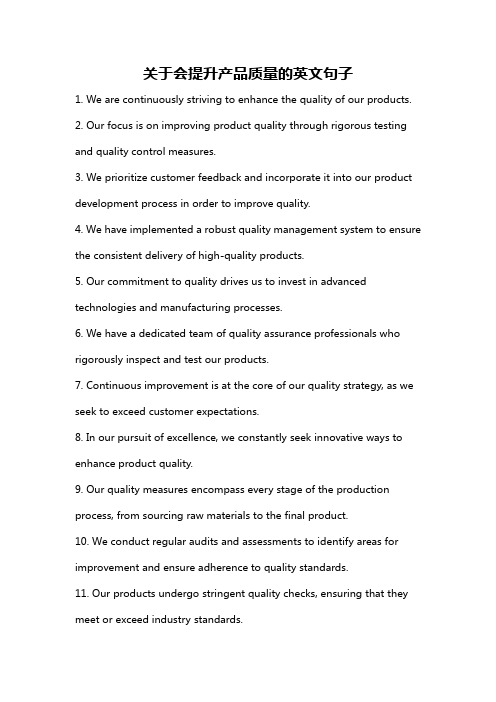
关于会提升产品质量的英文句子1. We are continuously striving to enhance the quality of our products.2. Our focus is on improving product quality through rigorous testing and quality control measures.3. We prioritize customer feedback and incorporate it into our product development process in order to improve quality.4. We have implemented a robust quality management system to ensure the consistent delivery of high-quality products.5. Our commitment to quality drives us to invest in advanced technologies and manufacturing processes.6. We have a dedicated team of quality assurance professionals who rigorously inspect and test our products.7. Continuous improvement is at the core of our quality strategy, as we seek to exceed customer expectations.8. In our pursuit of excellence, we constantly seek innovative ways to enhance product quality.9. Our quality measures encompass every stage of the production process, from sourcing raw materials to the final product.10. We conduct regular audits and assessments to identify areas for improvement and ensure adherence to quality standards.11. Our products undergo stringent quality checks, ensuring that they meet or exceed industry standards.12. We have established a feedback loop with our suppliers to address any quality issues promptly.13. Our quality control team conducts thorough inspections to eliminate any defects or inconsistencies in our products.14. We believe that quality is not a one-time achievement but a continuous effort, and we are committed to raising the bar.15. We invest heavily in employee training and development to ensure a high level of quality in our products.16. Quality is embedded in our company culture, and every employee is accountable for delivering superior products.17. Our quality management system is certified to international standards, validating our commitment to product excellence.18. We actively engage with customers to understand their evolving needs and expectations, enabling us to improve product quality accordingly.19. Feedback from the market plays a crucial role in our quality improvement initiatives, as we strive to stay ahead of the competition.20. Our dedication to quality sets us apart as a trusted provider ofhigh-quality products in the industry.。
DMAIC质量方法DMAIC是指定义(Define)、测量(Measure)、分析
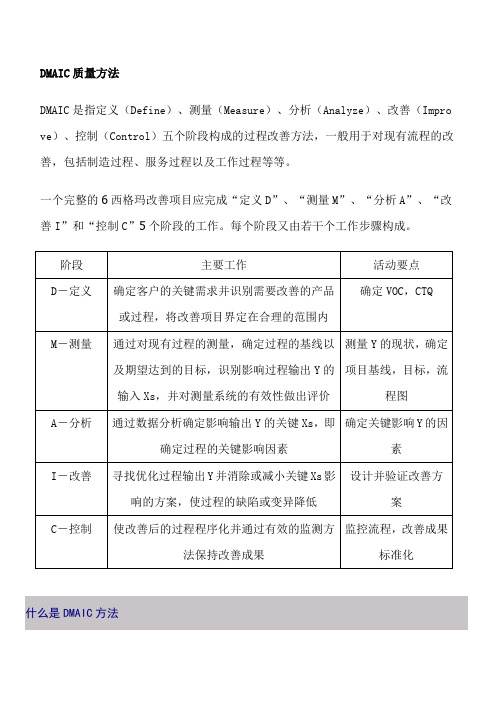
DMAIC质量方法
DMAIC是指定义(Define)、测量(Measure)、分析(Analyze)、改善(Impro ve)、控制(Control)五个阶段构成的过程改善方法,一般用于对现有流程的改善,包括制造过程、服务过程以及工作过程等等。
一个完整的6西格玛改善项目应完成“定义D”、“测量M”、“分析A”、“改善I”和“控制C”5个阶段的工作。
每个阶段又由若干个工作步骤构成。
6西格玛管理不仅是理念,同时也是一套业绩突破的方法。
它将理念变为行动,将目标变为现实。
这套方法就是6西格玛改进方法DMAIC和6西格玛设计方法DFSS。
DMAIC是指定义(Define)、测量(Measure)、分析(Analyze)、改进(Improve)、控制(Control)五个阶段构成的过程改进方法,一般用于对现有流程的改进,包括制造过程、服务过程以及工作过程等等。
DFSS是Design for Six Sigma的缩写,是指对新流程、新产品的设计方法。
一个完整的6西格玛改进项目应完成“定义D”、“测量M”、“分析A”、“改进I”和“控制C”5个阶段的工作。
每个阶段又由若干个工作步骤构成。
虽然,Motorola、GE、6Sigma Plus、Smart Solution等采用的工作步骤不尽相同,有的采用6步法,有的采用12步法或24步法。
但每个阶段的主要内容是大致相同的。
各阶段的主要工作如表5-1所示:
表5-1:DMAIC过程各阶段的主要工作
每个阶段都由一系列工具方法支持该阶段目标的实现。
表5-2列出了每个阶段使用的典型方法与工具:。
DMAIC报告范文

DMAIC报告范文I. IntroductionDMAIC (Define, Measure, Analyze, Improve, Control) is a process improvement methodology used to optimize processes. It is typically used to improve existing processes but can also be used to evaluate processes that are new or are being redesigned.This DMAIC report outlines the process improvement efforts for a hypothetical organization. The goal of the project was to identify and implement improvements to reduce the cost of goods sold while maintaining a high standard of quality.II. DefineThe project goals were identified as reducing the cost of goods sold while maintaining the quality of products. We also identified the process environment and key stakeholders.III. MeasureThe second step in the DMAIC process is to measure the current state of the process. We did this by collecting and analyzing data from the current process. We looked at historical data such as cost and quality metrics as well as data from process participants.We also mapped out the existing process and created a process flow diagram to illustrate the current state. This gaveus a better understanding of the actual process and helped us identify potential areas for improvement.IV. AnalyzeThe third step in the DMAIC process is to analyze the data collected. We used a variety of analytical techniques to determine cause and effect relationships and to identify areas of improvement.We looked at the process flow diagram and identified steps that were redundant, inefficient, or unnecessary. We then evaluated each step to determine how it could be improved.V. ImproveThe fourth step in the DMAIC process is to implement improvements. We identified several areas of potential improvement and developed solutions.We also identified ways to reduce costs by eliminating unnecessary steps in the process and utilizing more cost-effective materials.VI. ControlThe fifth and final step in the DMAIC process is to establish controls to maintain the improvements. We established a system of checks and balances to ensure that the process was running smoothly and that costs were being kept down.We also implemented performance metrics to measure the effectiveness of the improvements. We then established feedback loops so that any issues with the process could be quickly identified and addressed.VII. ConclusionIn conclusion, we successfully identified and implemented improvements to reduce the cost of goods sold while maintaining a high standard of quality. We used the DMAIC process toidentify areas for improvement, develop solutions, and establish controls to ensure the changes were successful.。
dmaic

dmaicDMAIC(Define, Measure, Analyze, Improve, Control),中文翻译为“确定、测量、分析、改进、控制”,是一种用于解决问题和改进过程的方法论。
它是六西格玛(Six Sigma)方法的核心工具之一,被广泛应用于各个行业和组织中。
本文将介绍DMAIC的每个阶段以及如何在实践中使用它来解决问题和改进过程。
首先,DMAIC的第一个阶段是“确定”(Define)。
在这个阶段,团队需要明确问题的范围和目标。
这包括确定问题的背景和原因,了解相关的业务流程,并确定改进的目标。
在这个阶段,团队可以使用一些工具和技术,如项目规划图(Project Charter)、业务流程图和问题陈述(Problem Statement)来帮助明确问题的范围和目标。
接下来,DMAIC的第二个阶段是“测量”(Measure)。
在这个阶段,团队需要收集相关的数据并进行分析。
这包括确定关键的过程指标(Key Process Indicators)和收集相关的数据。
团队可以使用一些统计工具和技术,如测量系统分析(Measurement System Analysis)和过程能力分析(Process Capability Analysis),来帮助他们理解当前过程的性能和问题所在。
然后,DMAIC的第三个阶段是“分析”(Analyze)。
在这个阶段,团队需要深入分析已收集的数据,以找出问题的根本原因。
团队可以使用一些分析工具和技术,如鱼骨图(Fishbone Diagram)和5Why分析,来帮助他们识别问题的主要原因。
通过分析数据和找出问题的根本原因,团队可以更好地制定改进的方案。
在DMAIC的第四个阶段“改进”(Improve)中,团队需要制定并实施改进方案。
这包括生成改进的解决方案,进行实验和验证,以及更新相关的工作指导和流程。
团队可以使用一些创新工具和技术,如质量功能展开(Quality Function Deployment)和实验设计(Experimental Design),来帮助他们制定和实施改进方案。
六西格玛 dmaic原理
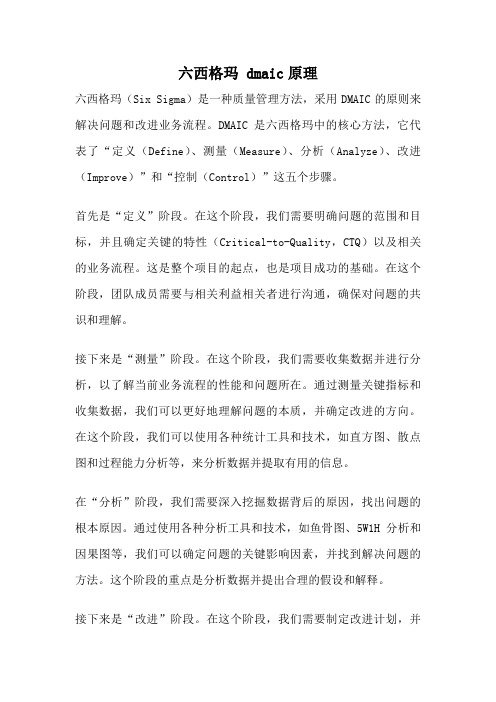
六西格玛 dmaic原理六西格玛(Six Sigma)是一种质量管理方法,采用DMAIC的原则来解决问题和改进业务流程。
DMAIC是六西格玛中的核心方法,它代表了“定义(Define)、测量(Measure)、分析(Analyze)、改进(Improve)”和“控制(Control)”这五个步骤。
首先是“定义”阶段。
在这个阶段,我们需要明确问题的范围和目标,并且确定关键的特性(Critical-to-Quality,CTQ)以及相关的业务流程。
这是整个项目的起点,也是项目成功的基础。
在这个阶段,团队成员需要与相关利益相关者进行沟通,确保对问题的共识和理解。
接下来是“测量”阶段。
在这个阶段,我们需要收集数据并进行分析,以了解当前业务流程的性能和问题所在。
通过测量关键指标和收集数据,我们可以更好地理解问题的本质,并确定改进的方向。
在这个阶段,我们可以使用各种统计工具和技术,如直方图、散点图和过程能力分析等,来分析数据并提取有用的信息。
在“分析”阶段,我们需要深入挖掘数据背后的原因,找出问题的根本原因。
通过使用各种分析工具和技术,如鱼骨图、5W1H分析和因果图等,我们可以确定问题的关键影响因素,并找到解决问题的方法。
这个阶段的重点是分析数据并提出合理的假设和解释。
接下来是“改进”阶段。
在这个阶段,我们需要制定改进计划,并实施这些计划。
改进计划应该基于对问题的深入分析和理解,并应该有针对性地解决问题的根本原因。
在实施改进计划时,团队成员需要密切合作,确保计划的顺利执行,并及时调整和修正。
最后是“控制”阶段。
在这个阶段,我们需要确保改进措施的持续有效性,并制定一套可行的控制措施来监控和维护业务流程的稳定性。
这个阶段的关键是建立一套可靠的控制机制,以确保改进的持久性和可持续性。
通过以上的DMAIC步骤,六西格玛可以帮助组织解决问题、改进业务流程,并提高质量和效率。
它的核心思想是基于数据和事实的分析和决策,强调持续改进和客户满意度。
品质管理常用英文术语

品质管理常用英文术语在品质管理领域,掌握一些常用的英文术语对于有效地沟通、理解和实施品质管理策略至关重要。
以下是一些常见且重要的品质管理英文术语。
一、基本术语1、 Quality 质量指产品或服务满足规定或潜在需要的特征和特性的总和。
2、 Quality Assurance (QA) 质量保证为使人们确信产品或服务能满足质量要求,在质量管理体系中实施并根据需要进行证实的全部有计划和有系统的活动。
3、 Quality Control (QC) 质量控制为达到质量要求所采取的作业技术和活动。
4、 Inspection 检验对产品或服务的一种或多种特性进行测量、检查、试验、度量,并将结果与规定的要求进行比较以确定其符合性的活动。
二、统计过程控制(SPC)相关术语1、 Process 过程将输入转化为输出的一组相互关联或相互作用的活动。
2、 Variation 变异过程的输出之间的差异。
3、 Control Chart 控制图用于区分过程中的正常变异和异常变异的一种统计工具。
4、 Upper Control Limit (UCL) 上控制限控制图中控制上限的值。
5、 Lower Control Limit (LCL) 下控制限控制图中控制下限的值。
6、 Center Line (CL) 中心线控制图中代表过程均值的线。
三、抽样检验相关术语1、 Sample 样本从总体中抽取的一部分个体。
2、 Sampling 抽样抽取样本的过程。
3、 Random Sampling 随机抽样按照随机原则抽取样本的方法。
4、 Acceptance Sampling 验收抽样确定一批产品是否可被接受的抽样检验方法。
四、缺陷与不合格相关术语1、 Defect 缺陷产品或服务中不满足预期使用要求的特性或特征。
2、 Nonconformity 不合格未满足规定的要求。
3、 Major Defect 主要缺陷可能导致产品或服务失效或严重降低其使用性能的缺陷。
如何进行有效的品质管理
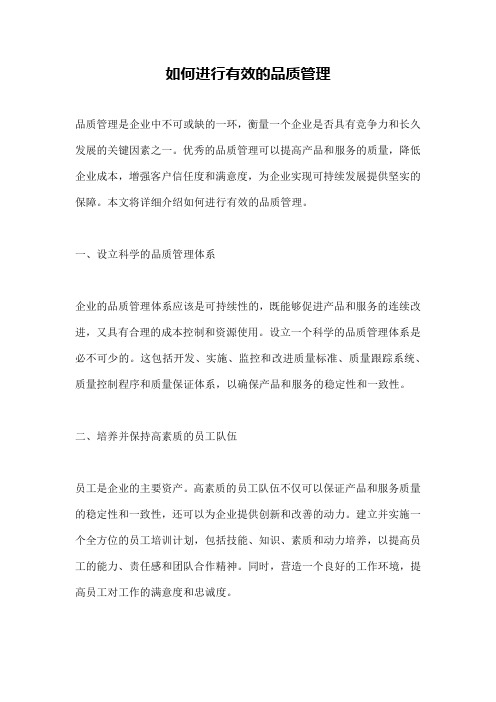
如何进行有效的品质管理品质管理是企业中不可或缺的一环,衡量一个企业是否具有竞争力和长久发展的关键因素之一。
优秀的品质管理可以提高产品和服务的质量,降低企业成本,增强客户信任度和满意度,为企业实现可持续发展提供坚实的保障。
本文将详细介绍如何进行有效的品质管理。
一、设立科学的品质管理体系企业的品质管理体系应该是可持续性的,既能够促进产品和服务的连续改进,又具有合理的成本控制和资源使用。
设立一个科学的品质管理体系是必不可少的。
这包括开发、实施、监控和改进质量标准、质量跟踪系统、质量控制程序和质量保证体系,以确保产品和服务的稳定性和一致性。
二、培养并保持高素质的员工队伍员工是企业的主要资产。
高素质的员工队伍不仅可以保证产品和服务质量的稳定性和一致性,还可以为企业提供创新和改善的动力。
建立并实施一个全方位的员工培训计划,包括技能、知识、素质和动力培养,以提高员工的能力、责任感和团队合作精神。
同时,营造一个良好的工作环境,提高员工对工作的满意度和忠诚度。
三、采用先进的生产工艺和技术手段生产工艺和技术是品质管理的关键因素之一。
采用先进的生产工艺和技术手段可以提高生产效率、精度和一致性,减少废品率和损失。
同时,控制和监测生产过程和结果以保证产品和服务的稳定性和一致性。
四、加强供应商管理和合作供应商的质量直接影响产品和服务的质量。
加强供应商管理和合作可以确保供应商的质量标准和性能,并降低供应链风险、成本和时间。
建立并实施一个全面的供应商评估、选择、培训和监测体系,确保供应商完全符合企业的品质标准和要求。
五、建立质量文化和品牌形象建立一个积极的质量文化和品牌形象可以增强企业的品牌价值和市场竞争力。
通过内部沟通、培训、奖励和公开宣传等方式,强调品质第一和客户满意度等价观,建立和保护企业品牌形象和声誉,提高客户信任度和忠诚度。
六、实施持续改进计划品质管理是一个不断改进的过程。
企业应该设立并实施一个持续改进计划,包括识别、分析和纠正产品和服务的不足之处、实施过程改进和创新、建立关键绩效指标和质量控制体系、并且追求完美和卓越。
DMAIC介绍

Process Flow Diagram
Delay
NO
Rework
Rework
YES
Scrap
Press 475C Injection Mold Part Mold #H1017
Operator Removes
Part & Inspects
NO
NO
Good Part YES
Operator Degates & Trims Part
– P/TV - 13%
1500
• Check Fixture / Caliper Gage R&R
– P/T - 20%
1000
– P/TV - 19%
• Ranking Gage R&R
500
– P/T - 12% – P/TV - 11%
0
1
2
3
4
5
6
7
8
9
10
11
12
13
14
15
16
17
18
Measure─測量
供應商
原材料
過程
產品
客戶
Supplier
Input CTI
x
Process CTP x
Output CTQ
y
Customer VOC
CTQ的測量方式,以及其測量系統的正確性。
目前CTQ的結果是多少。
列出可能和CTQ有關的X,可以先行繪製過程圖,找出所有 可能的X。
初步篩選掉一部份不需要分析的X。
– Wanda Drayton, Operator
– Laura Jacobs, Operator
DMAIC方案范文
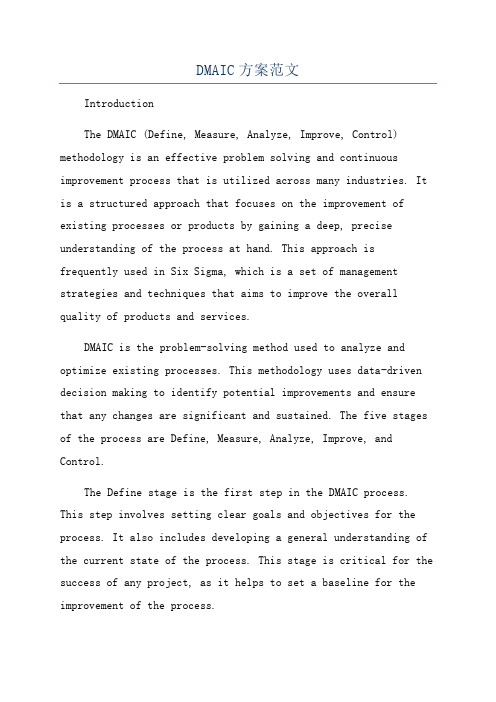
DMAIC方案范文IntroductionThe DMAIC (Define, Measure, Analyze, Improve, Control) methodology is an effective problem solving and continuous improvement process that is utilized across many industries. It is a structured approach that focuses on the improvement of existing processes or products by gaining a deep, precise understanding of the process at hand. This approach isfrequently used in Six Sigma, which is a set of management strategies and techniques that aims to improve the overall quality of products and services.DMAIC is the problem-solving method used to analyze and optimize existing processes. This methodology uses data-driven decision making to identify potential improvements and ensure that any changes are significant and sustained. The five stages of the process are Define, Measure, Analyze, Improve, and Control.The Define stage is the first step in the DMAIC process. This step involves setting clear goals and objectives for the process. It also includes developing a general understanding of the current state of the process. This stage is critical for the success of any project, as it helps to set a baseline for the improvement of the process.The Measure stage is the second step in the DMAIC process. This step is used to accurately measure and collect data on the existing performance of the process. It is important to accurately measure and collect data in the Measure stage because the data collected will be used as the foundation for further analysis.The Analyze stage is the third step in the DMAIC process. During this stage, the data collected in the Measure stage is analyzed and used to identify areas of potential improvement. It is important to have a clear understanding of the process performance and what can be improved in order to identify the most effective improvement strategies.The Improve stage is the fourth step in the DMAIC process. During this stage, improvement strategies are put into action. This is done by testing and evaluating the effectiveness of the strategies and then using the results to make changes to the process.The Control stage is the fifth and final step in the DMAIC process. This step is used to monitor and control the improved process performance. It is important to maintain a focus on the process performance in order to ensure that the desired results are consistently achieved.ConclusionThe DMAIC approach is a highly effective methodology for improving existing processes in order to increase efficiency and productivity. The five-step approach of Define, Measure, Analyze, Improve, and Control is used to systematically identify and improve processes. This approach is used by many industries in order to reduce costs, improve quality, and achieve desired performance levels. When implementing the DMAIC process, it is important to ensure that all steps are followed in order to maximize the potential gains.。
流程管理中常见的业务术语英文缩写
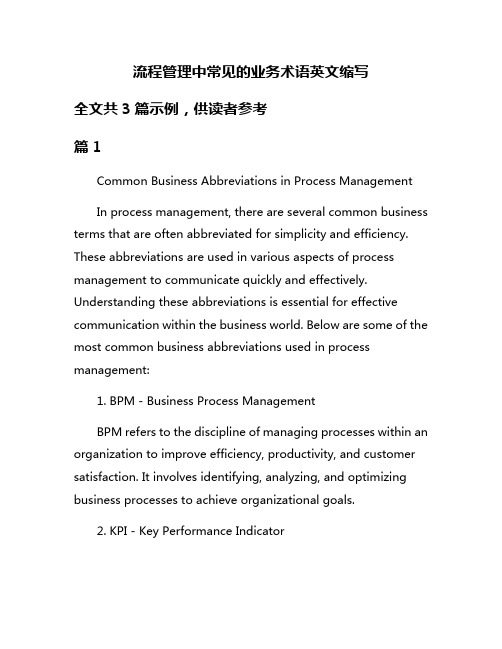
流程管理中常见的业务术语英文缩写全文共3篇示例,供读者参考篇1Common Business Abbreviations in Process ManagementIn process management, there are several common business terms that are often abbreviated for simplicity and efficiency. These abbreviations are used in various aspects of process management to communicate quickly and effectively. Understanding these abbreviations is essential for effective communication within the business world. Below are some of the most common business abbreviations used in process management:1. BPM - Business Process ManagementBPM refers to the discipline of managing processes within an organization to improve efficiency, productivity, and customer satisfaction. It involves identifying, analyzing, and optimizing business processes to achieve organizational goals.2. KPI - Key Performance IndicatorKPIs are measurable values that demonstrate how effectively a company is achieving its objectives. They are used to evaluate the success of a particular process or activity within an organization.3. SLA - Service Level AgreementAn SLA is a contract between a service provider and a client that outlines the expected level of service, including response times, availability, and performance metrics.4. SOP - Standard Operating ProcedureSOPs are detailed instructions that outline the steps to be followed for a particular process or task. They ensure consistency and quality in the execution of tasks within an organization.5. CRM - Customer Relationship ManagementCRM is a strategy used by organizations to manage relationships and interactions with their customers. It involves data analysis, customer profiling, and personalized communication to improve customer satisfaction.6. ERP - Enterprise Resource PlanningERP systems integrate various functions within an organization, such as finance, human resources, and supply chainmanagement, into a single system. This allows for seamless communication and collaboration between different departments.7. RPA - Robotic Process AutomationRPA is the use of software robots or artificial intelligence to automate repetitive tasks and streamline business processes. It can help organizations improve efficiency and reduce human error.8. ROI - Return on InvestmentROI is a financial metric that measures the profitability of an investment. It is calculated by dividing the net profit of an investment by the initial cost and expressing the result as a percentage.9. SOW - Statement of WorkA SOW is a document that outlines the scope, deliverables, and timeline of a project. It serves as a contract between a client and a service provider, detailing the expectations and requirements of the project.10. PMP - Project Management ProfessionalPMP is a globally recognized certification for project managers. It demonstrates the individual's expertise in project management, including planning, execution, and monitoring of projects.These are just a few of the common business abbreviations used in process management. Familiarizing yourself with these abbreviations can help you communicate more effectively within your organization and understand important concepts related to process management.篇2In the field of process management, business terminology can often be abbreviated for convenience and efficiency. These abbreviations, or acronyms, are frequently used in communication, documentation, and discussions among professionals. Below are some common business terms used in process management along with their English abbreviations:1. Business Process Management (BPM)BPM is a systematic approach to improving an organization's processes. It involves managing, controlling, and improving processes within an organization to achieve better efficiency and effectiveness.2. Key Performance Indicators (KPIs)KPIs are metrics used to evaluate the success of an organization or specific activities within an organization. KPIs are used to measure progress towards strategic goals and objectives.3. Service Level Agreement (SLA)An SLA is a contract between a service provider and a customer that stipulates the level of service that will be provided. SLAs define the expectations, responsibilities, and guarantees for a service.4. Business Process Outsourcing (BPO)BPO involves contracting out specific business functions or processes to external service providers. This can include services such as customer support, IT services, human resources, and accounting.5. Customer Relationship Management (CRM)CRM is a strategy for managing interactions with customers and potential customers. It often involves the use of software and technology to organize, automate, and synchronize sales, marketing, customer service, and technical support.6. Business Process Reengineering (BPR)BPR is the redesign of business processes to achieve significant improvements in cost, quality, speed, and service. It often involves radical changes in an organization's processes and can lead to dramatic improvements in performance.7. Enterprise Resource Planning (ERP)ERP is a software system used to manage and integrate the core functions of a business such as accounting, human resources, inventory, and supply chain management. ERP systems streamline processes and improve efficiency within an organization.8. Six SigmaSix Sigma is a set of techniques and tools for process improvement. The goal of Six Sigma is to reduce the number of defects in processes and products to near perfection. Six Sigma uses a data-driven approach to improving quality and reducing variation.9. Total Quality Management (TQM)TQM is a management approach that focuses on continuous improvement in all aspects of an organization. TQM involves theparticipation of all employees in a company and aims to improve quality and efficiency across all functions.10. Return on Investment (ROI)ROI is a financial metric used to evaluate the profitability of an investment. It is calculated by dividing the net profit of an investment by the initial cost of the investment. ROI is used to assess the effectiveness of investments and projects.These are just a few of the common business terms and their abbreviations used in process management. Understanding these terms and their meanings can help professionals communicate effectively and efficiently in the field of process management.篇3Common Business Term Abbreviations in Process ManagementIn the world of process management, there are numerous abbreviations and acronyms that are commonly used to describe specific business terms. These abbreviations help streamline communication and ensure clarity when discussing various processes within an organization. In this article, we will exploresome of the most common business term abbreviations used in process management.1. KPI - Key Performance IndicatorKPIs are metrics used by organizations to evaluate the success of a specific activity or process. They are typically quantifiable and provide an objective measure of performance.2. SLA - Service Level AgreementAn SLA is a contract between a service provider and a customer that defines the level of service expected. It outlines the responsibilities of both parties and sets specific performance metrics.3. SOP - Standard Operating ProcedureStandard Operating Procedures are established protocols that outline the steps required to complete a specific task or process. They ensure consistency and efficiency within an organization.4. CRM - Customer Relationship ManagementCRM systems are software tools used by businesses to manage interactions with current and potential customers. Theystore customer information, track sales opportunities, and improve customer satisfaction.5. ROI - Return on InvestmentROI measures the financial benefit gained from an investment compared to the cost. It is often used to evaluate the effectiveness of a particular project or initiative.6. BPR - Business Process ReengineeringBPR involves the redesign of business processes to improve efficiency, quality, and customer satisfaction. It often requires significant changes to organizational structure and workflow.7. BPM - Business Process ManagementBPM is a discipline that focuses on optimizing and improving business processes. It involves documenting, analyzing, modeling, and continuously improving processes to achieve organizational goals.8. ERP - Enterprise Resource PlanningERP is a software system that integrates various business functions, such as finance, human resources, and supply chain management. It helps streamline operations and improve data accuracy.9. JIT - Just-in-TimeJust-in-Time is a production strategy that aims to minimize inventory levels and reduce waste. It involves producing goods only when they are needed, thereby improving efficiency and reducing costs.10. FIFO - First In, First OutFIFO is a method of inventory management where the first items purchased or produced are the first ones to be used or sold. It ensures that older inventory is used before newer inventory.11. VSM - Value Stream MappingValue Stream Mapping is a visual tool used to analyze and improve the flow of materials and information in a process. It helps identify inefficiencies and opportunities for improvement.12. DMAIC - Define, Measure, Analyze, Improve, ControlDMAIC is a problem-solving methodology used in Six Sigma projects. It emphasizes the importance of defining the problem, measuring key metrics, analyzing data, implementing improvements, and controlling the process.13. TQM - Total Quality ManagementTQM is a management approach that focuses on improving quality and customer satisfaction. It involves continuous improvement, employee involvement, and a commitment to meeting customer needs.14. ABC - Activity-Based CostingABC is a cost accounting method that assigns costs to specific activities or processes based on their consumption of resources. It provides more accurate cost information than traditional costing methods.15. BOM - Bill of MaterialsA BOM is a list of components and parts required to manufacture a product. It includes details such as part numbers, quantities, and suppliers, and is essential for production planning and inventory management.These are just a few of the many abbreviations and acronyms used in process management. Familiarizing yourself with these terms can help improve communication and understanding within your organization. By speaking the same language and using common abbreviations, you can streamline processes, increase efficiency, and drive business success.。
品质改善方案

品质改善方案介绍在现代竞争激烈的商业环境中,优秀的产品品质是赢得市场竞争的关键。
品质改善方案是一种帮助企业优化产品和服务品质的方法论。
通过利用各种工具和方法,企业可以识别和解决品质问题,从而提供更好的产品和服务,提高客户满意度,并增强企业的竞争力。
本文将介绍几个常用的品质改善方案,包括质量管理体系、持续改进和六西格玛方法。
质量管理体系质量管理体系是一种系统化的方法,通过建立和执行一套严格的质量管理程序和标准来确保产品和服务的一致性和可靠性。
ISO 9001ISO 9001是一种国际标准,通过建立质量管理体系,帮助企业管理和改进质量。
ISO 9001强调组织内部的过程管理,包括质量策划、质量控制、质量保证和质量改进。
通过实施ISO 9001,企业可以优化流程,降低成本,提高产品可靠性,并提升客户满意度。
TQM全面质量管理(Total Quality Management,TQM)是一种管理方法,强调全员参与,持续改进和满足客户需求。
TQM鼓励员工参与到质量改进中,提倡质量优先和持续改进的文化。
通过采用TQM,企业可以有效地识别和解决质量问题,提高产品和服务品质。
持续改进持续改进是一种不断改进产品和服务品质的方法,通过不断收集反馈,分析数据和实施改进措施来提高质量。
PDCA循环PDCA循环是持续改进的基本方法之一,它是由四个步骤组成:计划(Plan)、实施(Do)、检查(Check)和行动(Act)。
通过循环执行PDCA,企业可以定期评估和改进质量管理过程,及时解决问题和预防问题的再次发生。
DMAIC方法DMAIC方法是六西格玛的核心方法之一,它是一种系统化的问题解决方法,包括五个步骤:定义(Define)、测量(Measure)、分析(Analyze)、改进(Improve)和控制(Control)。
通过使用DMAIC方法,企业可以识别和解决潜在的质量问题,提高产品品质和生产效率。
六西格玛方法六西格玛是一种基于数据和统计分析的方法,旨在提高产品和服务的质量,降低过程的变异性。
考研英语(一201)研究生考试试题与参考答案(2025年)
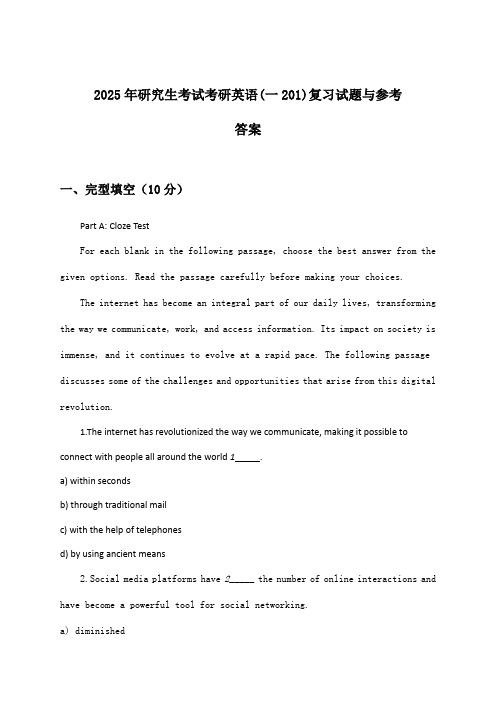
2025年研究生考试考研英语(一201)复习试题与参考答案一、完型填空(10分)Part A: Cloze TestFor each blank in the following passage, choose the best answer from the given options. Read the passage carefully before making your choices.The internet has become an integral part of our daily lives, transforming the way we communicate, work, and access information. Its impact on society is immense, and it continues to evolve at a rapid pace. The following passage discusses some of the challenges and opportunities that arise from this digital revolution.1.The internet has revolutionized the way we communicate, making it possible to connect with people all around the world 1_____.a) within secondsb) through traditional mailc) with the help of telephonesd) by using ancient means2.Social media platforms have 2_____ the number of online interactions and have become a powerful tool for social networking.a) diminishedb) increasedc) remained stabled) decreased3.One of the primary challenges of the digital age is the 3_____ of information overload.a) abundanceb) scarcityc) diversityd) precisionpanies are using big data analytics to 4_____ customer preferences and improve their services.a) predictb) ignorec) eliminated) overlook5.The rise of e-commerce has 5_____ the way we shop, offering convenience and a wider variety of products.a) transformedb) complicatedc) simplifiedd) eliminated6.While the internet has brought numerous benefits, it has also given riseto issues such as 6_____.a) improved educationb) increased job opportunitiesc) cybersecurity threatsd) better healthcare7.Online learning platforms have made education more accessible, allowing students to 7_____ courses from the comfort of their homes.a) submitb) participate inc) purchased) donate8.The rapid development of artificial intelligence has sparked 8_____ about the future of work and the potential displacement of jobs.a) excitementb) optimismc) concernd) indifference9.Internet privacy is a growing concern, with many users feeling that their personal data is not 9_____.a) secureb) accessiblec) sharedernments around the world are working to 10_____ internet regulations to ensure a safe and secure online environment.a) establishb) dismantlec) modifyd) ignore11.The internet has 11_____ the way we consume news, with many people relying on social media for updates.a) enrichedb) diminishedc) diversifiedd) consolidated12.One of the biggest advantages of the internet is its 12_____ in terms of information sharing and collaboration.a) limitationsb) benefitsc) challengesd) costs13.Online communication can sometimes lead to misunderstandings due to a lack of 13_____.a) clarityc) privacyd) access14.Cybersecurity experts are constantly working to 14_____ new threats and vulnerabilities.a) addressb) createc) ignored) eliminate15.The internet has 15_____ the global economy, facilitating international trade and business operations.a) boostedb) weakenedc) stabilizedd) diversified16.One of the challenges of the digital age is the 16_____ of digital literacy skills.a) shortageb) abundancec) diversityd) uniformity17.The internet has 17_____ the boundaries of traditional education,allowing for more personalized learning experiences.a) expandedb) narrowedc) maintainedd) eliminated18.While the internet offers numerous benefits, it also presents 18_____ in terms of mental health and well-being.a) opportunitiesb) challengesc) distractionsd) advancements19.Many people argue that the internet has 19_____ our attention spans, making us more prone to multitasking and shorter attention spans.a) extendedb) decreasedc) maintainedd) diversified20.Despite its challenges, the internet remains a powerful tool that has the potential to 20_____ our lives in countless ways.a) enrichb) degradec) isolated) confineAnswers:1.a) within seconds2.b) increased3.a) abundance4.a) predict5.a) transformed二、传统阅读理解(本部分有4大题,每大题10分,共40分)First QuestionPassage:“The Evolution of the English Language”The history of the English language is typically divided into three periods: Old English (approximately 450 to 1100 AD), Middle English (1100 to 1500), and Modern English (from 1500 to the present day). The language spoken during the Old English period was very different from the English we use today; it was heavily influenced by Germanic languages due to the Anglo-Saxon invasions. After the Norman Conquest in 1066, French became the language of the royal court and the ruling classes, which led to a significant number of French words being incorporated into the English vocabulary.During the Middle English period, the language began to take on a more familiar form as the influence of Latin and French from the Church and the Normansblended with the existing Germanic base. This period also saw the Great Vowel Shift, a major change in pronunciation that started around the 15th century and continued through the 17th century, transforming the sound system of the English language.Modern English emerged as a result of various linguistic changes and innovations, including the invention of the printing press, which standardized spelling, and the Renaissance, which introduced many Greek and Latin terms into the language. Today, English continues to evolve, absorbing new words from cultures all over the world, reflecting the globalized nature of our society.1、What were the main influences on Old English?A) Latin and FrenchB) French and ItalianC) Germanic languages and LatinD) Germanic languages and French2、When did the English language begin to shift significantly towards its modern form?A) After the Norman ConquestB) Around the 15th centuryC) During the RenaissanceD) In the 18th century3、Which event is credited with standardizing English spelling?A) The Norman ConquestB) The Great Vowel ShiftC) The invention of the printing pressD) The Renaissance4、What does the passage suggest about the current state of the English language?A) It is no longer evolving.B) It has stopped borrowing words from other languages.C) It remains static and unchanged since the Middle English period.D) It is continuing to evolve and incorporate new words from various cultures.5、Which of the following best describes the impact of the Great Vowel Shift?A) It introduced French vocabulary into English.B) It led to changes in the pronunciation of English vowels.C) It standardized the spelling of English words.D) It marked the beginning of the Old English period.Answers:1、D2、B3、C4、D5、B第二题Read the following passage and answer the questions that follow.The advent of the internet has revolutionized the way we access information and communicate with others. From the early days of dial-up modems to the lightning-fast speeds of today’s 5G n etworks, the internet has grown exponentially. This rapid expansion has not only brought about convenience but also raised concerns about privacy and security.1.The passage discusses the impact of the internet on:a)Educationb)Communicationc)Entertainmentd)Transportation2.The phrase “revolutions the way we access information” suggests that the internet has:a)Made information less accessibleb)Had no impact on information accessc)Made information more accessibled)Brought about confusion in information access3.The term “exponentially” implies that the growth of the internet has been:a)Slow and steadyb)Unpredictablec)Very fast and intensed)Gradual and consistent4.The passage mentions that the internet has brought about both convenience and concerns. Which of the following is NOT mentioned as a concern?a)Privacy issuesb)Security breachesc)Increased traffic congestiond)Loss of face-to-face interactions5.The author’s tone towards the internet can be described as:a)Highly criticalb)Indifferentc)Positive and optimisticd)Negative and skepticalAnswers:1.b) Communication2.c) Made information more accessible3.c) Very fast and intense4.c) Increased traffic congestion5.c) Positive and optimisticThird QuestionPassage:In today’s fast-paced world, technology has become an indispensable part of our lives. It shapes how we communicate, learn, and even entertain ourselves. One area where technology has made significant strides is in education. The advent of e-learning platforms has revolutionized traditional classroom settings, making education more accessible and flexible than ever before.However, the integration of technology into education is not without its challenges. Critics argue that excessive reliance on technology could lead toa decrease in face-to-face interaction among students, potentially weakening their social skills. Moreover, there is concern about the digital divide, which refers to the gap between those who have ready access to digital technology and those who do not. This disparity can exacerbate existing educational inequalities if not properly addressed.Despite these concerns, proponents of educational technology believe that the benefits far outweigh the drawbacks. With the right policies in place to ensure equitable access and usage, technology can serve as a powerful tool to enhance learning experiences and outcomes.Questions:1、What is one major benefit of integrating technology into education according to the passage?Answer: The major benefit mentioned is that technology makes education more accessible and flexible through e-learning platforms.2、What potential drawback of technological integration into education is mentioned?Answer: A potential drawback is the decrease in face-to-face interactions among students, which might weaken their social skills.3、How does the passage define the term “digital divide”?Answer: The “digital divide” is defined as the gap between those who have ready access to digital technology and those who do not.4、What concern is raised regarding the digital divide in the context ofeducation?Answer: The concern is that the digital divide could exacerbate existing educational inequalities.5、According to the passage, what condition must be met to harness the full benefits of educational technology?Answer: The condition stated is that there need to be right policies in place to ensure equitable access and usage of technology.第四题Reading Passage:In the era of digital technology, the importance of traditional reading skills has often been overlooked. However, reading traditional books offers numerous benefits that cannot be replicated by digital devices. This passage discusses the advantages of reading traditional books over digital ones.The benefits of reading traditional books are multifaceted. Firstly, it enhances cognitive development. The physical act of turning pages and holding a book requires more engagement from the reader, which leads to better concentration and comprehension. Secondly, reading traditional books promotes relaxation and reduces stress. The tactile experience of holding a book and the soothing sound of pages turning create a calming atmosphere that is conducive to relaxation. Thirdly, traditional books offer a unique sense of ownership and connection. Collecting books and having them on a shelf creates a personal library that is a reflection of one’s personality and interests. Lastly,traditional books have a longer lifespan than digital devices, making them a more sustainable choice.Despite the numerous benefits of reading traditional books, the rise of digital technology has led to a decline in book reading. Many people now prefer to read on e-readers or smartphones, which are more convenient and portable. However, this convenience comes at a cost. E-readers and smartphones can be addictive, leading to shorter attention spans and reduced concentration. Additionally, the screen glare and blue light emitted by digital devices can be harmful to one’s eyes and overall health.The importance of traditional reading skills cannot be overstated. Reading traditional books offers numerous benefits that contribute to cognitive development, relaxation, personal connection, and sustainability. While digital technology has its advantages, it is crucial to maintain the habit of reading traditional books to reap these benefits.Questions:1、What is the main advantage of reading traditional books mentioned in the passage?A. They are more portable.B. They enhance cognitive development.C. They are more convenient.D. They are more sustainable.2、According to the passage, how does reading traditional books contributeto relaxation?A. It provides a soothing sound of pages turning.B. It enhances cognitive development.C. It promotes social interaction.D. It helps in reducing stress.3、What is one of the unique benefits of traditional books mentioned in the passage?A. They have a longer lifespan than digital devices.B. They can be easily shared with others.C. They are more durable than digital devices.D. They offer a personal sense of connection.4、Why does the passage mention the decline in book reading?A. Because digital technology is more convenient.B. Because traditional books are more expensive.C. Because people prefer to read on e-readers.D. Because traditional books are less accessible.5、What is the author’s main argument in the passage?A. Traditional books are better than digital devices.B. Digital technology is more beneficial for reading.C. Traditional reading skills are important to maintain.D. Digital devices are more sustainable than traditional books.Answers:1、B2、A3、D4、A5、C三、阅读理解新题型(10分)Section III Reading Comprehension (New Type)Part ADirections: There is a passage in this section. Each passage is followed by some questions or unfinished statements. For each of them there are four choices marked A), B), C), and D). You should decide on the best choice and mark the corresponding letter on Answer Sheet 2 with a single line through the centre.Passage:The rise of the Internet and the spread of social media have dramatically changed the way we communicate and interact with each other. One of the most significant impacts of these technologies is the transformation of traditional media, which has led to the emergence of new forms of media and communication. This shift has not only altered the way we consume information but also the way we create and share it.The traditional media landscape, dominated by newspapers, television, and radio, has been rapidly reshaped by the digital age. These platforms have adaptedto the digital environment, offering users more personalized and interactive experiences. However, the rise of digital media has also brought challenges, such as the spread of misinformation and the decline in the quality of content.One of the most notable developments in digital media is the rise of influencers. Influencers are individuals who have established a significant online presence and have gained a loyal following. They often use their platforms to promote products, services, or ideas, and their influence can be significant. The power of influencers lies in their ability to reach a large audience quickly and effectively.Despite the benefits, the influence of digital media and influencers raises important ethical and social questions. The spread of fake news, for instance, is a direct consequence of the rapid dissemination of information online. Moreover, the influence of influencers can sometimes lead to harmful behaviors, such as the promotion of unrealistic body image or the encouragement of materialism.The impact of digital media on society is multifaceted. It has democratized information, allowing individuals to access and share knowledge more easily than ever before. However, it has also created new forms of inequality, such as the digital divide, where individuals without access to the internet are left behind.Questions:1.What is the main topic of the passage?A) The rise of digital mediaB) The decline of traditional mediaC) The rise of influencersD) The impact of digital media on society2.According to the passage, what is one of the challenges brought by the rise of digital media?A) The increase in the quality of contentB) The spread of misinformationC) The decrease in the number of traditional media platformsD) The increase in the number of influencers3.Which of the following is NOT mentioned as an ethical or social question raised by the influence of digital media?A) The spread of fake newsB) The promotion of unrealistic body imageC) The increase in the number of newspapersD) The encouragement of materialism4.What is the author’s attitude towards the democratization of information by digital media?A) SkepticalB) NeutralC) SupportiveD) Critical5.The passage suggests that the digital divide can result in:A) More people having access to informationB) Less people having access to informationC) No change in the access to informationD) A more equal distribution of informationAnswers:1.D) The impact of digital media on society2.B) The spread of misinformation3.C) The increase in the number of newspapers4.C) Supportive5.B) Less people having access to information四、翻译(本大题有5小题,每小题2分,共10分)第一题Translate the following Chinese paragraph into English.中文段落:“近年来,随着科技的飞速发展,人们的生活方式发生了翻天覆地的变化。
DMAIC五步法

质量管理部
2006年11月
1
概述 Define(界定问题) Measure(测量) Analyze(分析) Improve(改进) Control(控制) 总结
© Copyright Quality 2
Management Dep. 2006
概述 Define(界定问题) Measure(测量) Analyze(分析) Improve(改进) Control(控制) 总结
界定问题 测量
分析
改进
控制
当你正在解决一个非常棘手的专业性问题时,你有没有碰到过这种 情况:当问题突然变得明朗,接下来呢?问题是不是会变得容易解决 了?事实上,一旦你了解了问题的实质,解决问题就会容易得多。
看看下面的例子——
X 一种问题陈述:“我们发出的电话帐单上存在太多的
错误,大量的客户涌进我们的客户服务部进行投诉并要求 更正。”
工具之三:SIPOC图
© Copyright Quality 17
Management Dep. 2006
Define界定问题——了解业务过程 Define Measure Analyze Improve Control
界定问题 测量
分析
改进
控制
SIPOC图能够为团队提供三个好处:
¾ 帮助团队通过一张简单的图来理解一个复杂的流程。 ¾ 确保所有的团队成员都以相同的方式看待和理解这个流程。 ¾ 帮助团队对项目的范围进行界定。
© Copyright Quality 7
Management Dep. 2006
Define(界定问题)
DMAIC 五步法
定义问题范 围,了解过 程。
六西格玛针对流程改进的方法

六西格玛针对流程改进的方法Six Sigma is a data-driven methodology used to improve business processes and reduce defects, which was first developed by Motorola. It focuses on identifying and eliminating the causes of defects and errors in manufacturing and business processes, using a set of quality management methods and statistical tools.六西格玛是一种数据驱动的方法论,用于改善业务流程和减少缺陷,最初由摩托罗拉公司开发。
它专注于识别和消除制造和业务流程中的缺陷和错误的原因,使用一套质量管理方法和统计工具。
There are five key steps in the Six Sigma method: Define, Measure, Analyze, Improve, and Control, also known as DMAIC. In the Define phase, the project goals are set and the process is defined. The Measure phase involves collecting data related to the process to establish a baseline. The Analyze phase focuses on identifying and analyzing the root causes of defects. The Improve phase involves developing and testing solutions to eliminate the root causes of defects. Finally, in the Control phase, the improvements are implemented and monitored to ensure they are sustained.六西格玛方法中有五个关键步骤:定义、测量、分析、改进和控制,也被称为DMAIC。
DMAIC是指定义
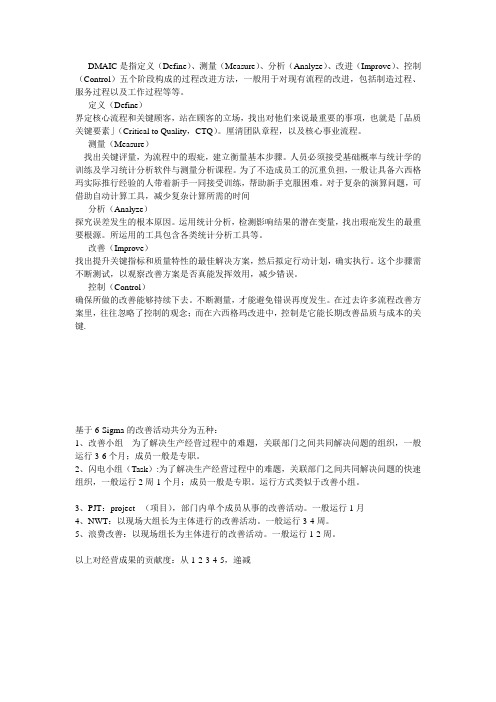
DMAIC是指定义(Define)、测量(Measure)、分析(Analyze)、改进(Improve)、控制(Control)五个阶段构成的过程改进方法,一般用于对现有流程的改进,包括制造过程、服务过程以及工作过程等等。
定义(Define)界定核心流程和关键顾客,站在顾客的立场,找出对他们来说最重要的事项,也就是「品质关键要素」(Critical to Quality,CTQ)。
厘清团队章程,以及核心事业流程。
测量(Measure)找出关键评量,为流程中的瑕疪,建立衡量基本步骤。
人员必须接受基础概率与统计学的训练及学习统计分析软件与测量分析课程。
为了不造成员工的沉重负担,一般让具备六西格玛实际推行经验的人带着新手一同接受训练,帮助新手克服困难。
对于复杂的演算问题,可借助自动计算工具,减少复杂计算所需的时间分析(Analyze)探究误差发生的根本原因。
运用统计分析,检测影响结果的潜在变量,找出瑕疪发生的最重要根源。
所运用的工具包含各类统计分析工具等。
改善(Improve)找出提升关键指标和质量特性的最佳解决方案,然后拟定行动计划,确实执行。
这个步骤需不断测试,以观察改善方案是否真能发挥效用,减少错误。
控制(Control)确保所做的改善能够持续下去。
不断测量,才能避免错误再度发生。
在过去许多流程改善方案里,往往忽略了控制的观念;而在六西格玛改进中,控制是它能长期改善品质与成本的关键.基于6-Sigma的改善活动共分为五种:1、改善小组---为了解决生产经营过程中的难题,关联部门之间共同解决问题的组织,一般运行3-6个月;成员一般是专职。
2、闪电小组(Task):为了解决生产经营过程中的难题,关联部门之间共同解决问题的快速组织,一般运行2周-1个月;成员一般是专职。
运行方式类似于改善小组。
3、PJT:project (项目),部门内单个成员从事的改善活动。
一般运行1月4、NWT:以现场大组长为主体进行的改善活动。
dmaic方法流程管理特点
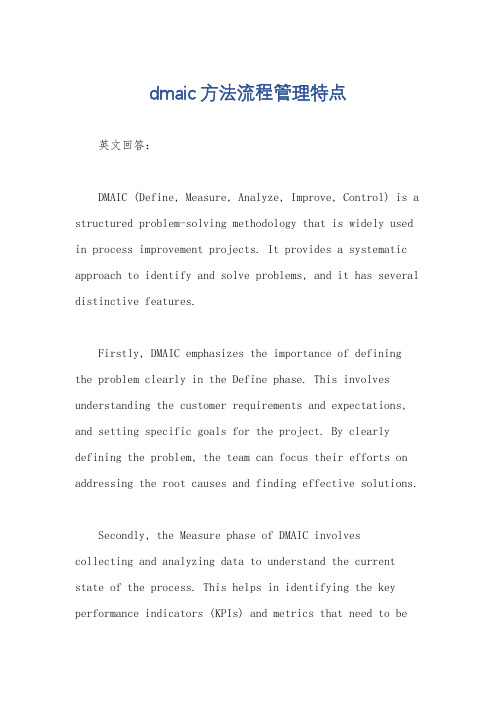
dmaic方法流程管理特点英文回答:DMAIC (Define, Measure, Analyze, Improve, Control) is a structured problem-solving methodology that is widely used in process improvement projects. It provides a systematic approach to identify and solve problems, and it has several distinctive features.Firstly, DMAIC emphasizes the importance of defining the problem clearly in the Define phase. This involves understanding the customer requirements and expectations, and setting specific goals for the project. By clearly defining the problem, the team can focus their efforts on addressing the root causes and finding effective solutions.Secondly, the Measure phase of DMAIC involvescollecting and analyzing data to understand the current state of the process. This helps in identifying the key performance indicators (KPIs) and metrics that need to beimproved. By using statistical tools and techniques, the team can gain insights into the process performance and identify areas for improvement.Thirdly, the Analyze phase of DMAIC involvesidentifying the root causes of the problem. This is done through data analysis, process mapping, and other problem-solving tools. By understanding the underlying causes of the problem, the team can develop targeted solutions that address the root causes and not just the symptoms.The Improve phase of DMAIC focuses on developing and implementing solutions to address the identified root causes. This may involve making process changes, implementing new technologies or systems, or redesigning workflows. The key is to find solutions that are practical, feasible, and sustainable.Finally, the Control phase of DMAIC involves putting measures in place to ensure that the improvements are sustained over time. This includes developing standard operating procedures, implementing control plans, andmonitoring the process performance to ensure that it remains within the desired range.In summary, DMAIC provides a structured and systematic approach to problem-solving and process improvement. It ensures that the problem is clearly defined, the root causes are identified, and effective solutions are implemented. By following the DMAIC methodology, organizations can achieve sustainable improvements in their processes and deliver better results to their customers.中文回答:DMAIC(定义、测量、分析、改进、控制)是一种在过程改进项目中广泛使用的结构化问题解决方法。
DMAIC精益生产持续改善
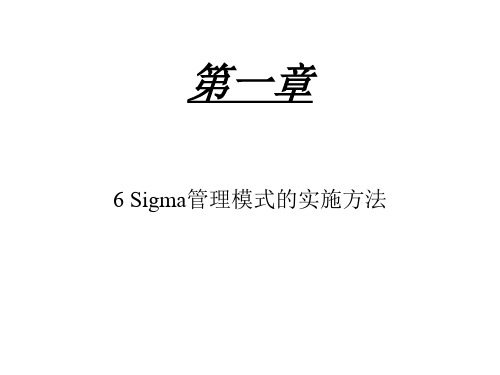
世界级的质量是公司生存的重要机会
困惑?------我们应该怎么做
1. 2. 3. 4. 开展与业务密切相关的项目 高层领导的重视--自上而下的推动 全员参与的培训和实践--边学边做 必要的投入带来高额的回报
开展6 Sigma 的关键成功因素
Equipment Delivery Quality 设备交货的质量 Modality Installation And Warranty Costs 装机和保修的成本 Design For Six Sigma 用Six Sigma设计 Uptime 开机时间
Define
Measure Measure
• Project CTQ 项目CTQ • Team Charter 项目规划 • High Level Process Map 高水平过程流程图
• Project Y(s) 项目 Y • Performance Standards for Y(s) Y的衡量标准 • Data Collection Plan & Validated Measurement System
缺陷
很难注意/预测 容易解决 容易看到 解决成本昂贵
6 Sigma 理 论 是 管 理 方 法 上 的 又 一 次 革 命
提 高 顾 客 满 意 度 的 经 营 策 略--------- 关 注 顾 客 需 求 衡量你的产品和服务 消除过程差异的工具 降低 劣质 成本量 世界级公司的衡量标准 --------- 关 键 质 量 要 求 (CTQs) --------- 生 产 的 稳 定 和 可 控 --------- 由 低 质 而 导 致 的 成 本 (COPQ) --------- 每 百 万 机 会 中 只 有 3. 4个 缺 陷
无级变速器带轮轴端面跳动超差问题分析

AUTO PARTS | 汽车零部件1 引言无级变速器(CVT)结构简单,动力传递平顺,工作速比范围宽,容易与发动机形成理想的匹配,进而降低油耗和排放。
同时具有较高的传送效率,功率损失少,经济性高。
CVT的核心零部件为控制速比的带轮组,通过推力钢带及主从动带轮组,实现无级变速。
核心零件带轮轴端面的尺寸精度控制水平也直接影响着与其装配配合的轴承工作工况,若端面跳动超差,轴承与端面装配精度下降,轴向游隙大小不均,产生应力集中,轴承寿命、旋转精度降低,同时引起其振动和噪声。
游隙过小的部位,会增加轴承磨擦发热和磨损,更会导致轴承寿命的降低。
本文基于公司CVT带轮轴端面跳动超差问题,运用DMAIC 质量工具分析问题原因并进行改进控制。
2 定义阶段定义阶段主要是确认顾客的关键需求并识别需要改进的产品或流程,组成项目团队,制定项目计划,确定要进行测量、分析、改进及控制的关键质量特性(CTQ),将项目完善于合理的区间范围。
2020年7月本司CVT机加工线主动带轮轴线一次下线合格率仅97.8%,严重低于公司质量目标要求(≥98.5%)。
将主轴线加工质量缺陷问题使用柏拉图展开,E02端面跳动超差问题占比高达50%,严重影响产线加工合格率及工废成本。
最终确定,关键需求及输出变量Y为主动带轮轴线E02端面跳动超差率,据此展开六西格玛项目进行问题分析。
(图1)SIPOC表示产品实现过程的主要活动,包括定义的范围和过程的关键因素。
通过供应商、输入、过程、输出、客户5个步骤进行分解,得到毛坯、工艺、车床、磨床、最终测量5个区域的可考虑因素,为后续阶段提供解决问题的方向。
根据产线缺陷率的纵向对比,确认项目目标为:超差率由50%降至10%,并制定5个阶段的相应时间计划。
3 测量阶段测量阶段是定义阶段的后续活动,也是连接分析阶段的桥梁,是事实和数据的具体表现。
通过流程图梳理,加深对过程的理解,发现其中潜在的问题,对产生问题和缺陷的重点区域进行定位。
工学硕士学位论文质量DMAIC流程管控
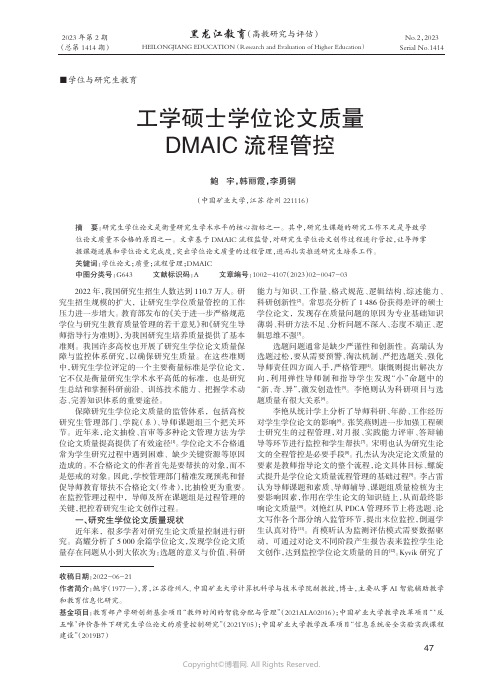
选题质量目标是从国家需求、导师研究方向、学科 专业背景确定。 学位论文选题目标通过论文关键词所 表述的领域是否符合国家战略需求, 是否和导师研究 方向相关,论文创新点是否为学科前沿内容,创新性解 决的问题是否存在和可行, 论文题目是否反映出论文 创新, 选题创新点的技术支撑是否通过文献综述确立 等方面确定目标。
在上述研究中可以看出, 研究生选题工作主要依 据导师的科研水平, 而盲审环节依赖于外审专家把握 尺度。 从研究生培养角度看,这两项工作属于导师的学 术水平评估内容。 而学位论文推进工作需要研究生与 导师交流、讨论,以及导师对学位论文进行提升和把 关。 从管理角度来看,尽管《研究生导师指导行为准则》 强调按照培养方案和时间节点要求, 指导研究生做好 论文工作,严格把关,但其并没有给出操作手段,需要 高校给出可操作的措施, 让研究生能够开展研究和论 文工作。 因此,依据研究生开展学位论文工作过程可测 数据,如论文修改、实验等,实现阶段性结果监控,是进 一步提高研究生论文质量的一个重要监管手段。
改进:研究 内容中科 研深度和 价值
分析:研究 方案实现 过程分析
论文修改对 主题、总体质 量的贡献分析
师 相 关 性 的 实 证 研 究 [J]. 国 家 教 育 行政学院学报,2015(4). [7]张笑燕,宋茂强.全日制专业学位硕 士研究生学位论文的过程管理与质
二、研究生学位论文 DMAIC 管控方案 (一)DMAIC 流程 六西格码(DMAIC)是一种解决持续改进问题的方 法[22],含五个阶段:定义(Define)、测量(Measure)、分析 (Analyze)、改进(Improve)、控制(Control)。 DMAIC 过程 是明确改进目标后,对产品制定衡量标准,实现产品关 键特性和过程参数的测量, 掌握过程关键点和决定要 素,找出当前产品质量与目标间差距,然后改进和优化 过程,控制生产实施来提升成果质量。DMAIC 流程管理 契合了对新知识的认知过程, 并为知识掌握设计出相 应可操作的阶段性工具,保证质量提升过程的推进。 相 对 PDCA,DMAIC 过程管理较为精细, 增加了改进过 程,可以更具体地跟踪学位论文质量提升过程。 (二)学位论文质量目标定义方法 学位论文质量改进总体目标定位是获得质量达标 的论文。 在外审之前,研究生论文的创作过程为:选题 与开题、阶段性成文、中期检查、整体成文、导师修改与 循环改进、课题组审核。 按照当前学位论文质量存在的 问题,对各个环节的质量目标进行定义。 受不同层次高校研究水平、不同学科的限制,研究 生论文质量标准很难做到统一的定义标准。 但同层次 高校,学位论文的质量标准基本相似,依据学位论文创 作过程和学科创新, 确立学位论文质量定义的基本方 向,建立多方面的综合目标,并在实施中改进。
